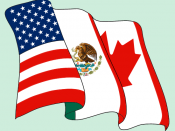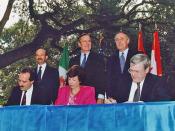The United States Central American Free Trade Agreement (CAFTA) is a trade agreement that is being negotiated between the United States and five Central American countries: Costa Rica, El Salvador, Guatemala, Honduras, and Nicaragua. "The United States is committed to opening markets around the world because American farmers, workers, consumers and businesses want to sell our world class goods and services. CAFTA will simplify trade; promote investment; slash tariffs on goods; remove barriers to trade in services; provide advanced intellectual property protections; promote regulatory transparency; strengthen labor and environmental conditions; and, provide an effective system to settle disputes," said U.S. Trade Representative Robert E. Zoellick.
The agreement's rules, which will go into effect immediately, includes the provision that 80% of U.S. exports of consumer and industrial goods will be duty free in Central America. The remaining 20% of consumer and industrial tariffs will be phased out over the next 10 years.
More than half of U.S. farm exports will also be duty free. Textiles and apparel will be duty free depending on whether they meet the Agreement's rule of origin, meaning that foreign yarn and fabric may be used in unlimited amounts. Other sections of the agreement include access to services such as telecommunications and a trade agreement for technological know-how. An important section of the CAFTA deals with protecting worker's rights and standardizing environmental behavior in Central America. Perhaps the most important component of CAFTA are stringent controls for protecting worker's rights and the environment, in contrast to previous free-trade agreements such as NAFTA.
Potential benefits that CAFTA offers, as World Bank research suggests, include the transfer of technology from the U.S., wider access to the U.S. market, and an increase in direct investment in Central American countries. Other opportunities for the Central American region includes investing more...


